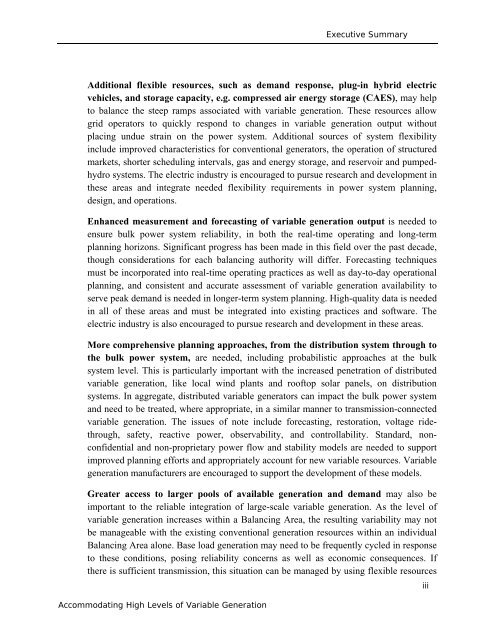Accommodating High Levels of Variable Generation - NERC
Accommodating High Levels of Variable Generation - NERC
Accommodating High Levels of Variable Generation - NERC
You also want an ePaper? Increase the reach of your titles
YUMPU automatically turns print PDFs into web optimized ePapers that Google loves.
Executive Summary<br />
Additional flexible resources, such as demand response, plug-in hybrid electric<br />
vehicles, and storage capacity, e.g. compressed air energy storage (CAES), may help<br />
to balance the steep ramps associated with variable generation. These resources allow<br />
grid operators to quickly respond to changes in variable generation output without<br />
placing undue strain on the power system. Additional sources <strong>of</strong> system flexibility<br />
include improved characteristics for conventional generators, the operation <strong>of</strong> structured<br />
markets, shorter scheduling intervals, gas and energy storage, and reservoir and pumpedhydro<br />
systems. The electric industry is encouraged to pursue research and development in<br />
these areas and integrate needed flexibility requirements in power system planning,<br />
design, and operations.<br />
Enhanced measurement and forecasting <strong>of</strong> variable generation output is needed to<br />
ensure bulk power system reliability, in both the real-time operating and long-term<br />
planning horizons. Significant progress has been made in this field over the past decade,<br />
though considerations for each balancing authority will differ. Forecasting techniques<br />
must be incorporated into real-time operating practices as well as day-to-day operational<br />
planning, and consistent and accurate assessment <strong>of</strong> variable generation availability to<br />
serve peak demand is needed in longer-term system planning. <strong>High</strong>-quality data is needed<br />
in all <strong>of</strong> these areas and must be integrated into existing practices and s<strong>of</strong>tware. The<br />
electric industry is also encouraged to pursue research and development in these areas.<br />
More comprehensive planning approaches, from the distribution system through to<br />
the bulk power system, are needed, including probabilistic approaches at the bulk<br />
system level. This is particularly important with the increased penetration <strong>of</strong> distributed<br />
variable generation, like local wind plants and ro<strong>of</strong>top solar panels, on distribution<br />
systems. In aggregate, distributed variable generators can impact the bulk power system<br />
and need to be treated, where appropriate, in a similar manner to transmission-connected<br />
variable generation. The issues <strong>of</strong> note include forecasting, restoration, voltage ridethrough,<br />
safety, reactive power, observability, and controllability. Standard, nonconfidential<br />
and non-proprietary power flow and stability models are needed to support<br />
improved planning efforts and appropriately account for new variable resources. <strong>Variable</strong><br />
generation manufacturers are encouraged to support the development <strong>of</strong> these models.<br />
Greater access to larger pools <strong>of</strong> available generation and demand may also be<br />
important to the reliable integration <strong>of</strong> large-scale variable generation. As the level <strong>of</strong><br />
variable generation increases within a Balancing Area, the resulting variability may not<br />
be manageable with the existing conventional generation resources within an individual<br />
Balancing Area alone. Base load generation may need to be frequently cycled in response<br />
to these conditions, posing reliability concerns as well as economic consequences. If<br />
there is sufficient transmission, this situation can be managed by using flexible resources<br />
<strong>Accommodating</strong> <strong>High</strong> <strong>Levels</strong> <strong>of</strong> <strong>Variable</strong> <strong>Generation</strong><br />
iii
















